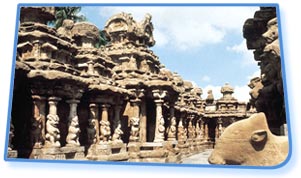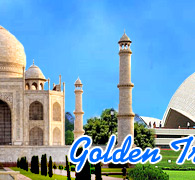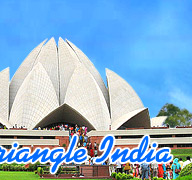Kanchipuram Tour Packages, Kanchipuram Tourism, Kanchipuram City, Kanchipuram Travel, Travel to India.
Kanchipuram City

Conjeevaram
is the English name of the ancient Kancheepuram. Like all ancient
cities, Kancheepuram is also situated on the banks of a river, Vegavati.
Kalidasa has described, it to be the best among the cities (Nagareshu
Kanchi) while Yuan Chwang, the great Chinese traveler, visited the city
in the 7th century and said that its people were famous for bravery and
piety as well as for their love of justice and veneration for learning.
He further recorded that Buddha had visited the place. As regards
learning, Kanchi stood second in glory only to Banaras. From the 3rd to
the 9th century A.D. Kanchi was the capital of the Pallavas who ruled
over the territory extending from the river Krishna in the north to the
river Kaveri in the south. The Pallavas fortified the city with
ramparts, moats, etc., with wide and well laid out roads and fine
temples. They were a great maritime power with contacts with far-off
China, Siam and Fiji through their chief Port Mamallapuram, the modern
Mahabalipuram. The Cholas ruled this town from 10th century to 13th
century. Kings of Vijayanagara dynasty ruled from 14th century to 17th
century. The temple tower, 192 feet height in Ekamabaranadhar temple and
100-pillar mandabam (building) in Varadaraja Perumal temple in this town
are famous for the architectural techniques of Vijayanagara Dynasty.
Ancient Kanchipuram, the city of thousand temples, is one of the seven
most sacred pilgrim centres for the Hindus. Kanchipuram owns 108 temples
dedicated to Siva and 18 to Vishnu besides scores of other temples,
mosques and churches and Adi Shankara Mutt. Today, apart from its
temples, this small town is also known for its thriving handloom
industry, traditional cotton and silk saris. The silk weavers of Kanchi
settled more than 400 years ago and have given it an enviable reputation
as the producer of the best silk sarees in the country.
| Location: |
In Tamil Nadu, India. |
| Significance: |
Seat of Shankracharya. |
| Climate: |
Tropical climate with almost uniform temperature, in summers, the temperature ranges between 36.6oC and 21.1oC while in winters, the temperatures varies from 28.7oC and 19.8oC. |
Shopping Attractions
Kanchipuram, more popularly known as the 'silk paradise' is world
renowned for its hand-woven silk saris, which are from pure mulberry
silk. Contrasting colors and better luster, durability and finish are a
result of weaving and dyeing tradition hundreds of years old. Today,
more than 5,000 families are engaged in this industry and their
creations are marketed by a number of co-operative societies located all
over the state.
Prime Attractions
Sri Ekambareswara Temple:
Sri Ekambareswara is in the form of "Prithvi Lingam" hence
Kanchipuram is also known as one of the Pancha Bhutha Sthalas. According
to a Puranic story, Kailash Parvathy closed the eyes of Lord Shiva,
while playing, bringing darkness to the entire world. Getting angry at
her behavior, Lord Shiva cursed Parvathi to become black like Kali.
Unable to bear the punishment the Goddess descended on this place and
did penance under a mango tree making a Lingam out of earth. Hence much
significance is attached to this shrine and the mango tree, situated
within the temple. The dimensions of this temple are reflected in its
20-acre spread and its tall south gopuram, which soars to a height of
58.5m.
Sri Kailasanathar Temple:
Rajasimha of the Pallava dynasty built the Kailasnathar temple during
the first quarter of the eighth century. Built of red sandstone, it has
innumerable carvings of Pallava art, of which the Urdhva Tandava dance
of Siva and the laughing face of Parvati are worth seeing. The
architecture of this temple resembles the Shore Temple at Mamallapuram.
Sri Vardaraja Perumal Temple:
The highlight of the Vishnu Kanchi is the temple of Varadarajaswamy,
atop the Hastigiri or Elephant Hill. The Vijayanagar kings constructed
this temple covering an area of about 23 acres. The sculptural beauty of
the pillars is amazing as are the ornamental rings carved out of single
stone at the Four Corners of the mandapam in the form of a chain.
Sri Kamakshiamman Temple:
One of the three Sakti peethas of India, Kanchi is the home to
Kamakshi, the Supergoddess, Parasakti, having Saraswati, Lakshmi and
Parvati as her eyes. She blesses all that dedicate themselves to her.
The sanctum sanctorum faces southeast in the centre of Gayatri Mandapam.
The tradition says that there was a delightful grove of Champaka trees
around the main temple now known as Gayatri Mandaparn.
Sri Ulagalandar Temple:
This Vaishnava Temple was built in Chola period .The main deity of this
temple is 35 feet high and 24 feet wide posing with one foot on earth
and the other on the sky. This form is called Trivikrama. This temple is
one of the 108 Divya Desam's of Lord Vishnu.
Sri Vaikunda Perumal Temple:
The Pallava ruler built this temple, Nandivarman in the seventh
century. Sri Vaikunda Perumal temple is famous for its architecture. The
Lord is in the sitting posture. The Goddess is known as Sri
Vaikunthavalli Tayar. It has great sculptures and inscription, which
speak of its history and the history of the city itself. Its inner walls
are decorated with lion shaped pillars.
Sri Kacchapaeswarar Temple:
Pallava Dynasty built Kacchapa Eswarar temple. In this temple, Siva
appears as being worshipped by Vishnu in the form of turtle
(kurmemerali). 'Kacchapam' is a Sanskrit word for 'Turtle', hence the
name 'Kacchapa Eswarar Temple'.
Sri Vijayaraghava Perumal Temple:
This temple of Vijayaraghava Perumal is one of the 108 Divyadesams
where Lord Rama is said to have performed the funeral rites for Jatayu,
the giant bird that valiantly fought to prevent Ravana from abducting
Sita, the wife of Lord Rama to Lanka.
Jain Temples at Tirupparuthikkundram:
Kanchipuram is an important landmark in the history of the Jains. Many
of the Pallava kings belonged to Jainism. The temples of the Jain
Tirthankaras were built in the ninth century. The temples contain
several fresco paintings and a grand image of Bhagwan Mahaveer.
Sri Subramaniya Swami Temple:
Subramaniya Swami temple was built around 1915. For Hindus on a
pilgrimage trip, this temple is a mandatory place to visit. It gains its
significance due to its location. The way this temple is located in the
city is a rare phenomenon mentioned in Hindu scriptures. It is called
the "Soma Skandha" Posture.
How To Reach
| By Air: |
The nearest airports are in Chennai, where there are both domestic and international airports with regular flights from all the major cities in India and abroad. |
| By Train: |
There are regular train services to and Chennai, Chengalpattu, Tirupati, and Bangalore, with the exception that trains for Chengalpattu do not run on national holidays. |
| By Road: |
75 km from Chennai, it is well connected by a network of roads and frequent bus services to and from Chennai, Bangalore and other places. |
 Conjeevaram
is the English name of the ancient Kancheepuram. Like all ancient
cities, Kancheepuram is also situated on the banks of a river, Vegavati.
Kalidasa has described, it to be the best among the cities (Nagareshu
Kanchi) while Yuan Chwang, the great Chinese traveler, visited the city
in the 7th century and said that its people were famous for bravery and
piety as well as for their love of justice and veneration for learning.
He further recorded that Buddha had visited the place. As regards
learning, Kanchi stood second in glory only to Banaras. From the 3rd to
the 9th century A.D. Kanchi was the capital of the Pallavas who ruled
over the territory extending from the river Krishna in the north to the
river Kaveri in the south. The Pallavas fortified the city with
ramparts, moats, etc., with wide and well laid out roads and fine
temples. They were a great maritime power with contacts with far-off
China, Siam and Fiji through their chief Port Mamallapuram, the modern
Mahabalipuram. The Cholas ruled this town from 10th century to 13th
century. Kings of Vijayanagara dynasty ruled from 14th century to 17th
century. The temple tower, 192 feet height in Ekamabaranadhar temple and
100-pillar mandabam (building) in Varadaraja Perumal temple in this town
are famous for the architectural techniques of Vijayanagara Dynasty.
Conjeevaram
is the English name of the ancient Kancheepuram. Like all ancient
cities, Kancheepuram is also situated on the banks of a river, Vegavati.
Kalidasa has described, it to be the best among the cities (Nagareshu
Kanchi) while Yuan Chwang, the great Chinese traveler, visited the city
in the 7th century and said that its people were famous for bravery and
piety as well as for their love of justice and veneration for learning.
He further recorded that Buddha had visited the place. As regards
learning, Kanchi stood second in glory only to Banaras. From the 3rd to
the 9th century A.D. Kanchi was the capital of the Pallavas who ruled
over the territory extending from the river Krishna in the north to the
river Kaveri in the south. The Pallavas fortified the city with
ramparts, moats, etc., with wide and well laid out roads and fine
temples. They were a great maritime power with contacts with far-off
China, Siam and Fiji through their chief Port Mamallapuram, the modern
Mahabalipuram. The Cholas ruled this town from 10th century to 13th
century. Kings of Vijayanagara dynasty ruled from 14th century to 17th
century. The temple tower, 192 feet height in Ekamabaranadhar temple and
100-pillar mandabam (building) in Varadaraja Perumal temple in this town
are famous for the architectural techniques of Vijayanagara Dynasty.











